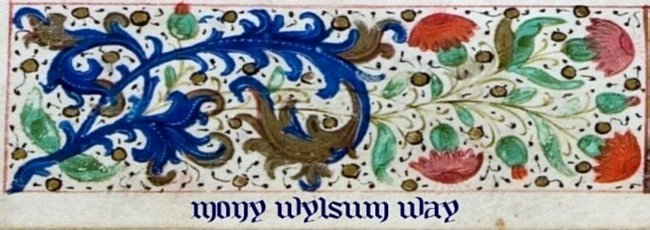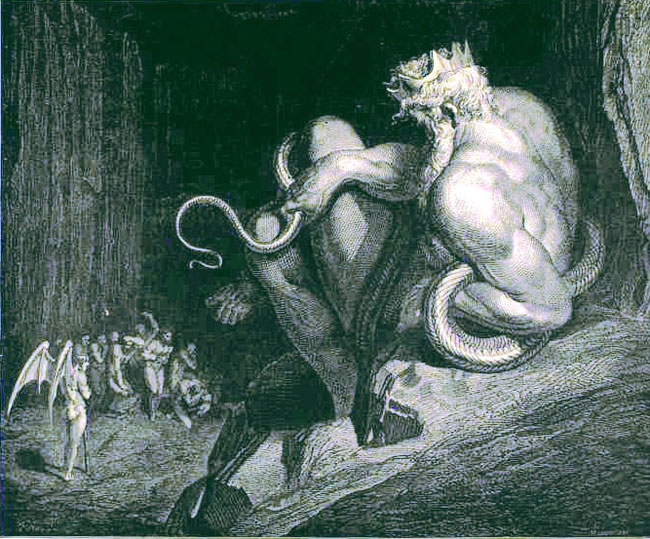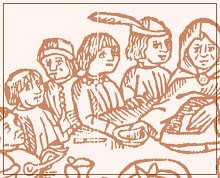In the medieval narratives [of female martyrs] good girl and bad girl alike were stripped only to mortify the flesh, whether at the behest of an evil emperor or of Satan, who oddly enough carries out the punishments to which sinners are condemned by God. (Caviness 85)Well, but it isn’t odd. At least according to the pattern of the Gilte Legend (which, incorporating as it does many different versions of many different stories from many different traditions, rarely has a pattern but does manage one in this case), infernal intervention in saints’ lives is always associated with the pattern of divine will. Fiends enact God’s purpose, both in demonstrating the saint’s glory and in performing divine vengeance on sinners. They get the dirty work, but their actions tend to God’s ends. Of course, from a narrative point of view, every character and action in a moralistic short story point towards the same moral end; but the articulation (by narrator, saints and fiends) of the fiends’ purposes show a deliberate unity between infernal and divine intentions.
I’ve only a few pages of the Gilte Legende with me here in Adelaide, and none have examples of Satan or fiends explicitly involved with a martyrdom (though, as I mention in my next post, they’re there ‘in spirit’ in the person of the tormentors). But of the eight pages I have (well, sixteen – eight photocopies of facing pages), there are enough consistent references to fiends to generalise about their behaviour – and they are far from autonomous.
When the son of the provost who sent St Agnes to the brothel goes to visit her there (presumably with rape in mind, given he takes a gang of his friends along), he is foiled by a/the fiend acting in concert with heavenly light:
And whanne he wolde haue touched her the bryghtnesse of the light come ayeinst hym, and he yelded no worshippes ne thankyngges to God, wherfor he was anone strangeled of the fende. (110)“Strangled by the fiend” (“strangled” can mean “smothered” or even just “killed”) seems almost a figure of speech (though of a piece with the literal behaviour of fiends elsewhere), until Agnes explains to his father that yes, in fact, agency in that act does belong to the devil, and is due explicitly to the boy’s choice of him over God:
He of whom he wolde fulfell the wille toke pouer vpon hym and slough hym, and whanne his felawes sayn the miracle of God thei turned ayein all dredfulli withouten any harme. (110)Moments like this in which fiends punish sinners usually occur as a direct result of some action by the saint[1] (though notice that the saint does not instruct the fiend to do so):
[St Longinus] toke an axe and braste doun all þe ydollis... And þe fendis þat wente oute of þe ydollis entrid into the [evil] prouost and within his felawis, and þay al torente hemself as madde men and knelid doun to Longius. (212)Longinus then removes the devils and restores the men to sanity[2]. Similarly,
... the preste of the idoles that hadde geue his counsell [to kill St Vitalis] was anone rauished withe the fende and was verray wood .vij. dayes and cried in the place wher Seint Vitall was buried: ‘Allas, Vitall, how thou brennest me.’ And in the .vij.te day þ fende threwe hym in the riuer wher he deied cursedly”. (284)Even when not punishing the saint’s tormentors, the fiends invariably (so far as I can recall) take action solely for the benefit of the saint – the moral and demonstrative benefit, that is, even if they humiliate his/her body. They enable the saint to either ascend to a higher moral plane, or (more commonly) to demonstrate his/her moral/spiritual superiority and the power consequently given him/her by God.
The demonstration, of course, works on two levels: to other characters in the narrative, and to the reader. Some incidents are designed more for one audience than the other: proof aimed at the world of the narrative often involves very public confrontation or spectacular miracles, as in the previous examples, while those aimed at the reader need not be witnessed by other characters, and are more likely to recall stories of Christ’s actions or passion.
Macarius, for example, is tested privately, “in the supulture of a dede man” in “a place of desert”, recalling Christ’s temptation in the wilderness[3] and his entombment (possibly also the harrowing of Hell). The fiends who find him have no purpose but “to make hym afraied”, and Macarius’ imperviousness causes them to flee, helpfully informing the audience as they go that he has “ouercome us”. Another more violent fiend later tries to attack him with a scythe, “but he myght not”. Macarius need not even speak to deter this fiend, as he is simply and mysterious impervious. This fiend is also handily explicit in not only demonstrating Macarius’ moral superiority, but explicating its nature to the reader:
And thanne he saide hym: ‘A, thou Makarie, thou makest me to suffre gret violence, for I may do nothyng ayeinst the. And I doo as thou doost, thou fastest and I ete not, thou wakest and I slepe not, but one thing is wherin thou ouercomest vs most.’ Thanne the abbot saide: ‘Wherin is that?’ And the fende saide: ‘Humilitie, wherfor I may do nothyng ayeinst the.’ (93)The place of the fiend in these tales is very ordered. It cannot be a true enemy, with motivations and agenda of its own, nor can it pose a real threat to the saint or to God’s plan. Though malicious, it acts only within God’s plan, and can have effect only against those who have already committed themselves to the devil by actions against God or God’s proxy. Attempted action against that proxy serves only their aggrandisement – and the fiends not only seem to know this, but sometimes get quite chatty with the saints about it (Longinus is another such). They may have rebelled originally against God, but they seem incapable of rebelling against their place as it is now in the natural order.
I am reminded of Dante’s Minos:
Gustav Doré's impression of Minos, 1890
Stavvi Minòs orribilmente, e ringhia:Minos crouches in the second circle, “horrible and growling”, examining the sins of all who come before him and, by the number of times he curls his tail, indicates the circle to which divine judgement condemns the sinner. Enacting God’s justice, he nevertheless remains monstrously other – an infernal other, not divinely elevated. He points doom with that least human organ, the tail, rather than the hand with which God made the world. Similarly, a loving God is not directly responsible for the horrors visited on the saint or meted out against his/her tormentors (as the saint does not instruct the fiends to punish the pagans); but nevertheless they remain part of a greater divine plan.
essamina le colpe ne l'intrata;
giudica e manda secondo ch'avvinghia.
Dico che quando l'anima mal nata
li vien dinanzi, tutta si confessa;
e quel conoscitor de le peccata
vede qual loco d'inferno è da essa;
cignesi con la coda tante volte
quantunque gradi vuol che giù sia messa. (Inferno V.4-12)
It seems to me this view of the fiend serves two functions: reassurance and permission. On the one hand, the fiend is not active in the world without the supervision of God: these torments, while physically horrific, not only guarantee the saint a place in God’s presence but are ordained by God, who ultimately has control over the situation, over the worst of what happens to us in life. On the other hand, by token of the first, the martyrdom is an act of God and may therefore be venerated, obsessed over, fetishised, depicted, relished as a work of literature or art. It creates and defines an acceptable way of looking, for images like this:
The flaying of St Bartholomew; Bibl. Nat. MS n. a. fr. 16251 fol. 67v. Le Livre d'images of Madame Marie, c. 1300.
[1] Note that in Agnes’ case the punishment is prompted not by her action but by action against her. I may have to collect a larger sample group to observe whether this is usually gendered. Cf. St Vitalis, whose death is the precipitating factor; though I think I would argue that for a saint martyrdom is an action, potentially the moment of their greatest power.
[2] Upon which, they kill him. At his own request. And the provost weeps for him. Saints are peculiar.
[3] And in Jerusalem, technically, thanks to Lucifer and his superspeed travel. And I’d just like to say that, if refusing the suggestion that you throw yourself off a tall building is a qualification for divinity, I manage to do that every day. Well, I would if more people suggested it to me on a regular basis. I think I would make a relatively sensible deity. Though some sects might carry out pogroms in the name of correct use of punctuation and antecedents.
Cited:
Caviness, Madeline H. Visualizing Women in the Middle Ages: Sight, Spectacle, and Scopic Economy. Philadelphia: University of Pennsylvania Press, 2001.
Dante. Inferno. Ed. Giorgio Petrocchi. Società Dantesca Italiana, 1994.




.jpg)


1 comment:
I don't really want to suggest that you jump off a tall building, because if you had an unexpectedly earthbound moment or a particularly persuasive fiend was put into your legend, you might not quite resist enough, and then this sort of blogpost would stop and it would be my fault and Minos would probably have a special place marked out for me in coils.
Or, in other words, thankyou, I enjoyed this one, but I hope your Ascension to godhood isn't due quite yet :-)
Post a Comment